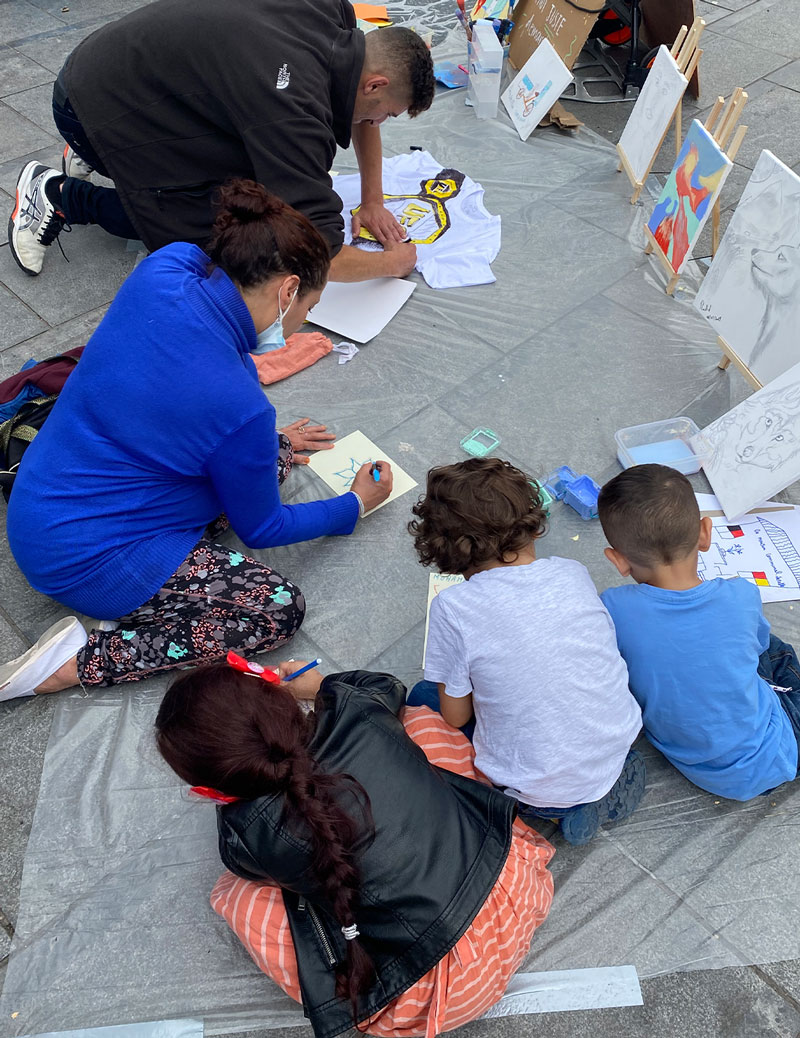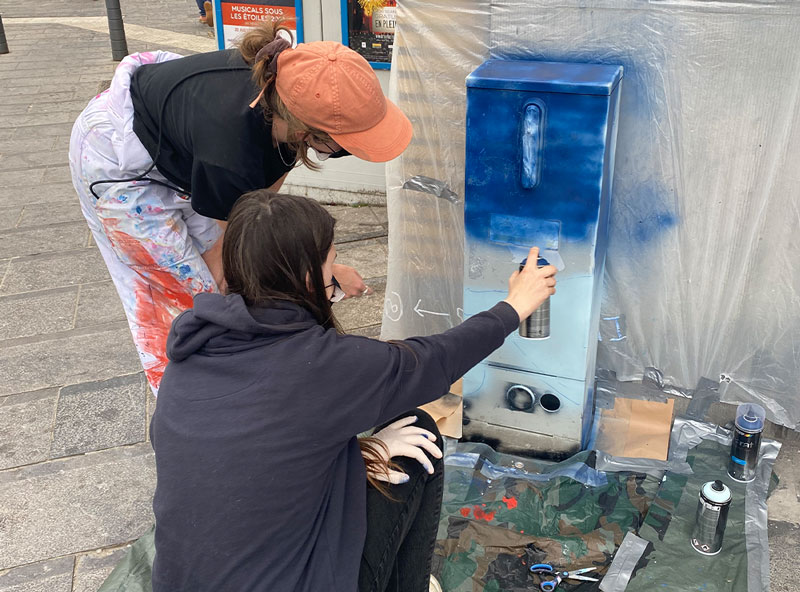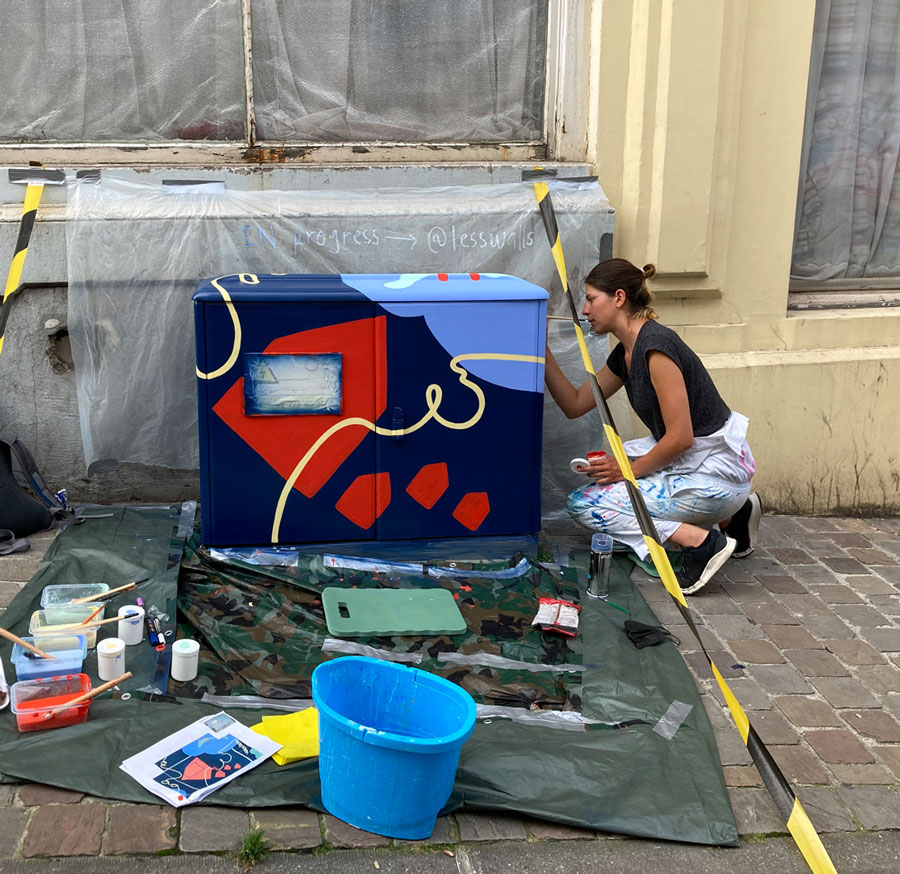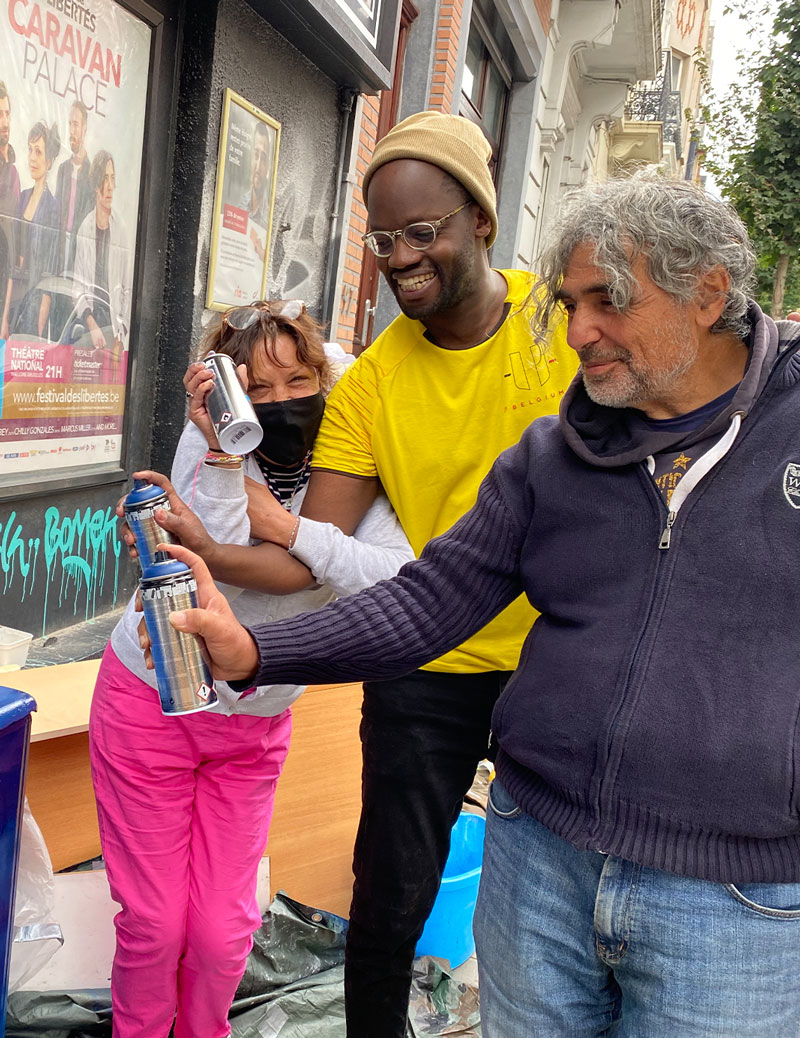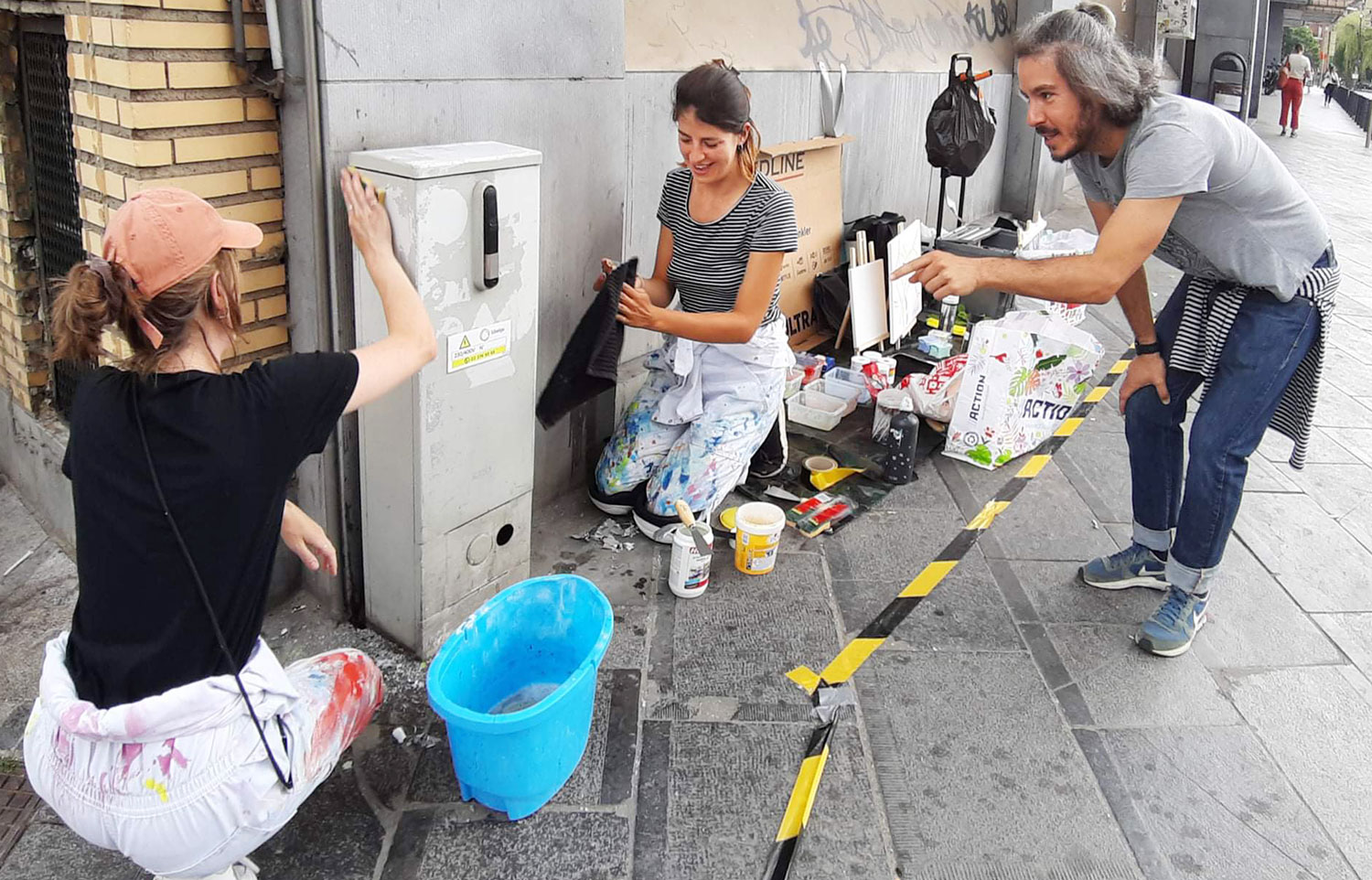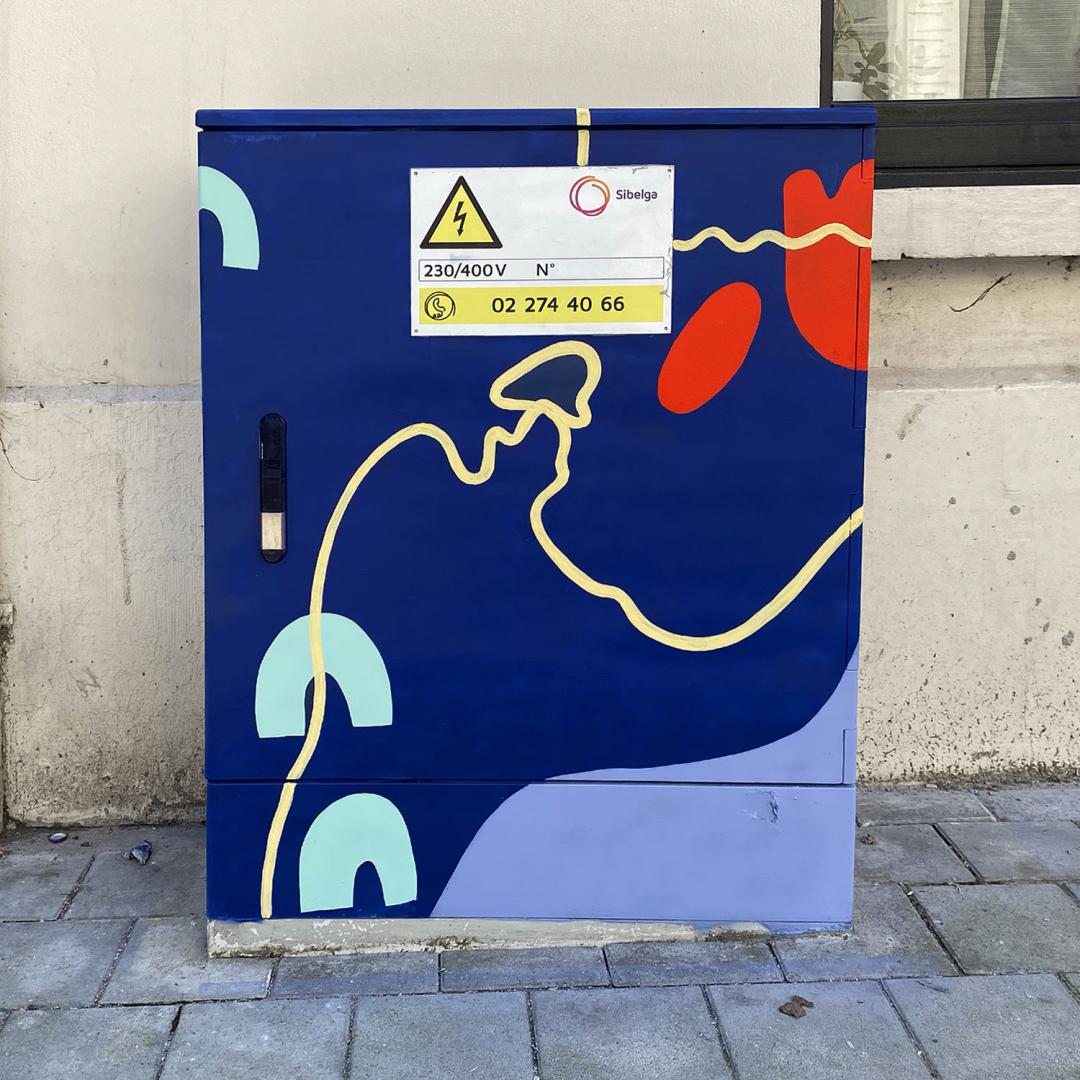Less Walls, More Bridges
Basic information
Project Title
Full project title
Category
Project Description
My downstairs neighbour is Maria, an Ethiopian woman with three children who has lived in Brussels for 15 years. Upstairs is Imad, a Lebanese journalist who arrived here six months ago. Everyday, I see Rashid walking by, a homeless man who gets his lunch from the foodbank around the corner. I know all this because I invited them all to paint utility boxes with me last summer with my project Less Walls, More Bridges.
Geographical Scope
Project Region
Urban or rural issues
Physical or other transformations
EU Programme or fund
Which funds
Description of the project
Summary
Less Walls, More Bridges is a project in which a series of utility boxes in Ixelles, Brussels were identified and used as a canvas to express the identity of local residents. Through participatory exercises and workshops with local residents, we collected different ideas for the design of these objects. In this process, we involved the following communities:
- Malinard: Local youth house of Ixelles
- Den Teirling: Local organisation who hosts activities for people who struggle with mental health
- La Bulle: mobile laundry providing services to homeless people
- Douche Flux: mobile shower providing services to homless people
- Elzenhof: Local cultural center ex Ixelles
- La Serre: Community center and meeting spot for neighbours
- Local shop owners: We talked to every single shopkeeper in Rue Malibran which was an essential step for the engagement of the local community
During the months of May and June 2021, we started to involve the inhabitants Ixelles. In order to make this phase as inclusive as possible, we used different channels of participation including Postcards, Spontaneous Pop-up sessions and planned Workshops with local organisations.
In the final phase of this creative process, all the contributions were transformed into a coherent whole, which was then distributed among the different utility boxes. With this project we were able to create moments where people could tap into their creativity, connect local residents with the public space (and other communities around them) and work towards a cleaner and safer environment.
Key objectives for sustainability
A cleaner public space
This project allowed for the cleaning of the public space. We found that the space around the electricity boxes tended to be dirty and an area where a lot of rubbish accumulated. By using these locations for the artwork, we engaged the local residents not only with the painting but also the preparation and cleaning of the boxes.
The deeper result was the sense of ownership and responsibility from each citizen engaged to keep the public space clean. This in turn, creates a ripple effect where citizens are more conscious of their surroundings and are incentivised to look after it.
Key objectives for aesthetics and quality
License for creativity
Another great strength of the project was its artistic nature. The fact that we engaged the communities via an artistic practice, combined with our targeted approach to include more vulnerable members of the neighbourhood meant that we were able to give people the opportunity to have access to some tools that they might not have in their daily lives.
An example of this was the continued engagement created for the beneficiaries of la Bulle and Denteirling. We had repeated interaction with both of these communities which showed the need for these types of activities in the neighborhood.
The stories we tell
From an artistic perspective, the design that was painted on the boxes was created in such a way that it would form part of a bigger picture (see attached report). In this way, every box told a story from that particular area since we matched each box to the organisation that was physically closest to it. This not only created an initial physical connection and continuation throughout the neighbourhood but also incentivised people to visit the other boxes, guiding the residents through different parts of their own neighbourhoods to facilitate encounters between the different communities beyond the project.
Future Collaborations
We saw this project as only the start of a journey to create greater social cohesion and connection with the public space in our own neighborhood, therefore another measure of success for our organization is the future opportunity to continue our artistic work in Ixelles, Brussels.
We will continue to collaborate with the Malinard youth house in 2022 with two projects on the pipeline, one to paint an internal mural with the young teenage girls and the second one to paint more electrical boxes with the young people of this organization.
Key objectives for inclusion
Connecting people & spaces
The main objective that we achieved with the project was to strengthen the connection between the residents and the neighborhood. We succeeded in making the project public and accessible by creating a bespoke approach to every community we interacted with, collaborating with each local organization.
Community outreach & communication
For this project, we used a combination of Online & Offline strategies in order to have the widest reach possible of the neighbourhood.
- Postcards: There were a total of 500 postcards distributed around the neighbourhood to raise awareness of the project and collect input for the conception of the overall design.
- Local Organisation Engagement: We decided to engage some local organisations in order to reach some specific communities around the area. These included:
- Malinard: Local youth house of Ixelles
- Denteirling: Local organisation who hosts activities for people who struggle with mental health
- La Bulle: mobile laundry providing services to homeless people
- Douche Flux: mobile shower providing services to homless people
- Elzenhof: Local cultural centre ex Ixelles
- La Serre: Community centre and meeting spot for neighbours
- Local shop owners: We talked to every single shop keeper in Rue Malibran which was an essential step for the engagemnet of the local community
- Pop up session: During June, we organised a two hour pop up session which was open for everybody who lived in the neighbourhood. We presented the attendees with various creative exercises which allowed them to explore their connections with Ixelles and to give us their perspectives on how they see their own neighbourhood.
The live painting enabled moments of interaction between different communities. By focusing on each organization with every box we painted, we allowed for spontaneous dialogues to start between the local residents and the more vulnerable communities
Results in relation to category
In relation to the “regaining as sense of belonging” category, the project’s focus was on the engagement rather than the outcome. We ensured an accessible approach where the community engagement was targeted to each local organisation working with vulnerable communities in the area. In this way, we were able to empower every participant that was involved with our project and meet their needs, developing a relationship around the painting activity and allowing them to do the same with others. We got the following insights:
Exposure to the community
Through the disarming nature of this project, we got a lot of contact with different communities in the neighborhood in precarious situations: homeless people, people with mental health disabilities and young people.
Although our encounters were not always optimistic, we were able to have deeper insights into what it is like to be an Ixelles resident and we feel the need for artistic projects in order to connect with the community in a more meaningful way.
Insights on organisations
We also had the privilege to have communication with inspiring organizations whose purpose is to meet the needs of these vulnerable communities.
For example we noticed that the workshops we did with La Bulle were very successful and it identified a clear need for activities which create a link between beneficiaries and their neighbours. This project also opened opportunities for collaboration between the local organisations which enables learning and deeper impact in their work.
Importance of partnerships
We have learnt that it is essential to tailor our approach to every single community we interact with. In order to do this successfully, it is imperative to create partnerships and work very closely with organizations which are already working on the ground.
It is also very important to be quite flexible in the way we schedule our interactions and allow for spontaneity when it is necessary.
How Citizens benefit
Engagement
During the months of May & June, we started the engagement process with the Malibran neighbourhood and its residents. In order to make this process and inclusive as possible, we used different methods of participation:
- Postcards: All residents and local traders of Malibran received a postcard with information about the project. The recipient could then submit/ draw ideas on the blank canvas.
- Local organisation engagement: We engaged various local organisations including: Malinard youth house, Deinterling, La Bulle, Elzenhof and local shopkeepers.
- Pop-up session: At the end of this collection phase, we organised a creative session where we entered dialogue with the neighbours about their stories and perceptions of the local area.
Live painting
During the first phase, we collected all kinds of ideas through various participation channels. By constantly receiving feedback and entering into dialogue with the local residents we were able to translate the results into a design that was coherent to be painted on the electricity boxes.
At the beginning of the summer holidays 2021 (July) we started with the cleaning and painting of the selected cabinets. During the painting days, we also had side creative activities to increase engagement since the electricity boxes are small and limited for participation. This process took three months to complete in collaboration with the local residents.
The concept for the artwork was around telling the stories of the neighbourhood with a continuous line throughout the electricity boxes. This consistency created a sense of identity not only for the project but also for the people that took part, making a strong visual connection between the physical boxes used for the project.
Physical or other transformations
Innovative character
Street art is a standard practice in Brussels, especially mural painting. You can find infinite techniques that are used to reflect on this capital city, a walking “museum” where artists are painting their responses to, in many cases, social issues.
What Less Walls, More Bridges aims to achieve is to not only join this street art movement but to open it up to citizens who have a physical connection with the space that is being painted, whether they work or live in the area, it is about giving them the opportunity to curate the artwork they see in theri shared spaces and participate to make it happen.
Our methodology is based on citizen participation and design justice practices and in this way, transforming the participants into the co-designers or artists themselves. We put a lot of emphasis on the outreach, especially of vulnerable communities because we are facilitating (more than art) dialogue between people and human connection.
Learning transferred to other parties
This project was very specific to the Ixelles neighbourhood in Brussels, however our methodology has allowed us to be flexible and apply it in different contexts.
Methodology
Our methodology is based on the following steps:
- Pre-Engagement (Inform & consult): This phase lasts around 3 months and it includes: Identifying ambassadors, contacting local organisations, mapping and engaging the community.
- Engagement (Involve): This phase can last 3 months and it involves entering into dialogue with the various residents, organising live events and collecting local stories
- Live project (Collaborate): This phase involves the live painting and facilitation of painting activities which enable the communities to strengthen their connection, it lasts around 1 month.
- Post-Engagement (Empower): After the project is completed, we allow for the sharing of insights, identification of future opportunities to keep the connections alive.
The methodology applied in other contexts
- A container in the north of Brussels: We transformed a container into a new hangout spot for young people from the Cureghem neighbourhood. We facilitated a series of brainstorming sessions involving the young people from Anderlecht and local residents in the design process and realisation of the painting.
- A homeless shelter in the city centre: We were invited to teach architecture students participatory practices in order to strengthen the social cohesion of a Homeless shelter in the context of its neighbourhood. Through painting a mural in the shelter we were able to empower them and strengthen their role as co-creators of their own space.
- A small remote village in Italy: We facilitated a workshop for youth workers around community engagement in Schiavi di Abruzzo, Italy. We organised various public interventions to value local stories of history, tradition and culture. We collected stories from the inhabitants of the village and d

